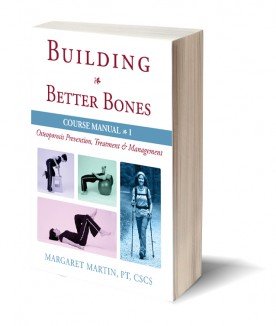Table of Contents
In today’s video lesson, I cover several recent developments in the areas of nutrition and pharmaceuticals for osteoporosis.
Tomorrow we cover what you should be doing to prepare to meet the demands of the large number of clients with low bone density and osteoporosis.
Continuing Education Course
I encourage you to check out the Building Better Bones online course for Physical Therapists, Physiotherapists, Kinesiologists, Athletic Trainers, Occupational Therapists and Physical Therapy Assistants.
Over 12,000 health professionals have completed this course.

“I thoroughly enjoyed taking Working with Osteoporosis and Osteopenia. It offered a firm foundation in understanding osteoporosis, as well as a practical approach to dealing with patients. It included everything from testing seniors’ fitness levels through to exercises for posture, flexibility, balance and strength. If you are looking for a well rounded approach to treating your osteoporosis patients, you should be on this course! Lots of practical ideas that you can take to work on Monday morning.” — Colleen MacDonald, Physical Therapist, Misericordia Hospital, Edmonton, Alberta
Nutrition and Pharmaceuticals for Osteoporosis
When it comes to nutrition and bone health, there’s quite a bit written about alkaline diets, a diet that is high in fruits and vegetables and low in saturated fats, but what I’d like to talk about today, specifically, is some recent research that looked at an important mineral and an important vitamin when it comes to bone health.
The Role of Vitamin D
Let’s start with Vitamin D.
In the spring of 2010, the general of the American Medical Association published an article that had just over 2,000 women in the average age 76 years of age and they were given mega doses of vitamin D once a year over a three to five year period.
So, mega doses, 500,000 international units, once a year. What this study found, was that these woman actually had an increased fracture risk. The medical advisory committee from Osteoporosis Canada had a couple of theories in regards to the increased risk of fractures. One of them was that the enzymes that are needed to break down the active vitamin D were being produced at too great a level.
Another theory was that people were feeling so good about having all that vitamin D and their muscle function was working so much better, that they were all of a sudden just being that much more active and that might have increased their risk of fractures. The main outcome of this study was that although vitamin D is a fat-soluble vitamin, we shouldn’t be recommending to our clients that they take all their vitamin D in one day of the year, but rather, getting it the way nature intended, a little bit every day. So, the recommendations in Canada still stand between 800 and 2,000 international units a day.
The Role of Calcium
As far as calcium, there is a study that was published in the British Medical Journal in the summer of 2010. It was actually a meta analysis. And this meta analysis looks specifically at calcium supplementation alone in women and it was quite alarming because they found that women that were taking high calcium supplementation had a significant increased risk of heart attacks. And so the recommendation is that calcium should not be taken alone because vitamin D helps with the absorption of calcium. Another recommendation in Canada was that the recommended levels of 1,500 milligrams per day for the adult population over the age of 50 was reduced to 1,200 milligrams a day.
Osteoporosis Pharmaceuticals
And so far, as pharmaceuticals, as healthcare professionals, it’s very important for us to be aware of the different medications that our clients are on and the effect that it has, when we’re talking about osteoporosis, on their bone health. And so, there are a lot of bisphosphonates. If you listen to any of the commercials that ran the six o’ clock news, you’re going to be bombarded by commercials on different bisphosphonates and not all bisphosphonates are created equal. Some bisphosphonates protect against vertebral fractures, some against non-vertebral factors and some against both. Now, all these bisphosphonates are not created equal and so, it’s important that you be aware and that’s one thing we go into in more detail in the MelioGuide course, is the type of bisphosphates that are available on the market.
Physical Therapy Continuing Education
To learn more about how to Physical Therapy Continuing Education, visit my page dedicated to Physical Therapy Continuing Education.

Comments